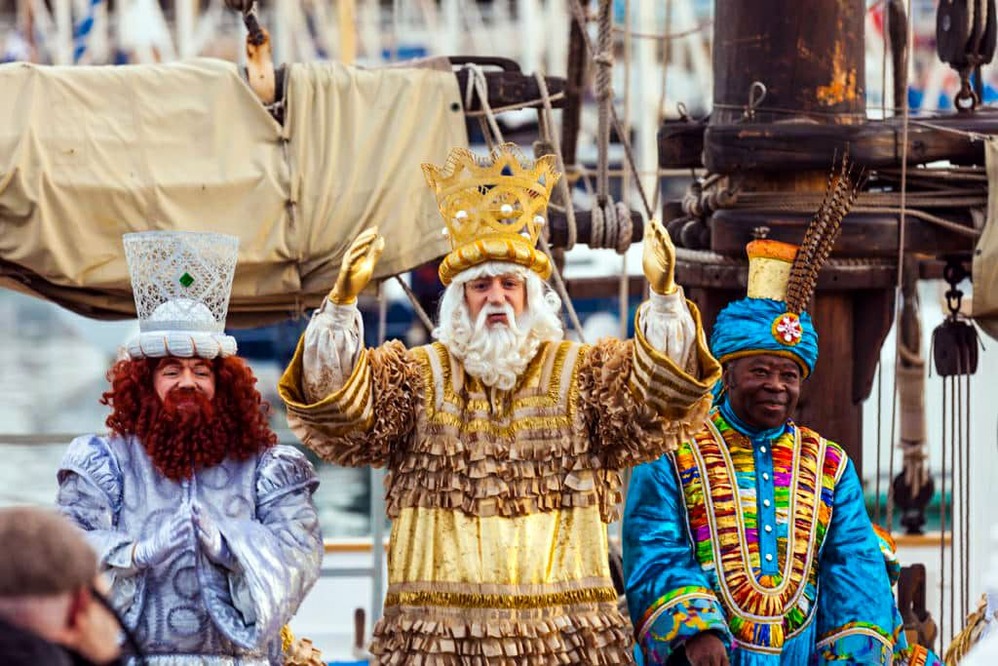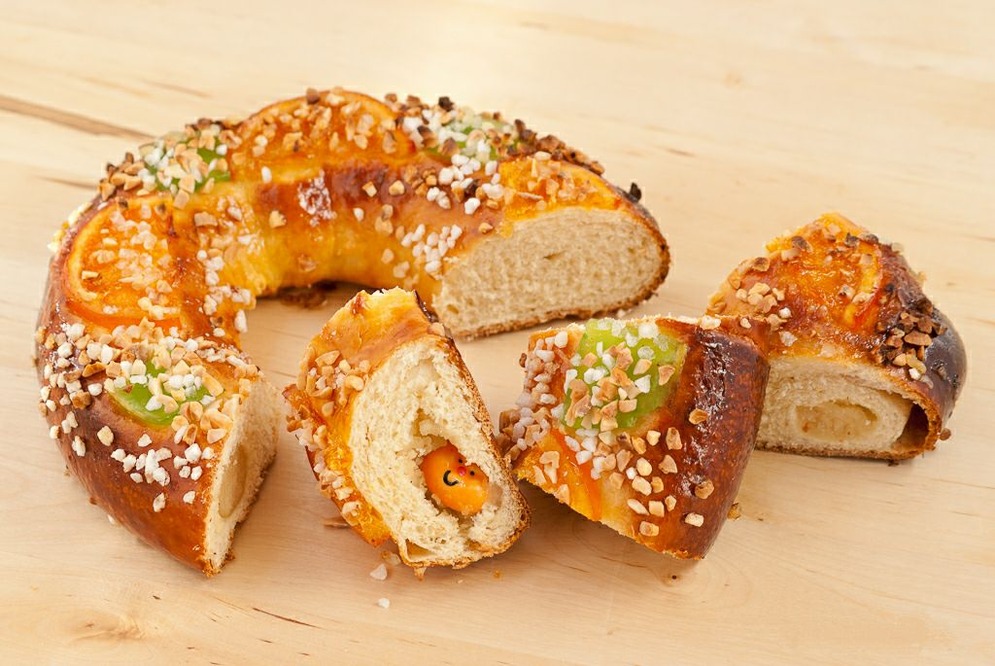Christmas in Catalonia and Barcelona — festive traditions and events
![]()
Christmas in Catalonia is a very special holiday. This region has unique traditions that are not found anywhere else. Some of the customs may seem strange to you because they relate to aspects of human life that are not associated with this religious event. Did we manage to intrigue you? Read our publication to learn about the main Christmas traditions in Catalonia and the places and events where the festive atmosphere is felt most vividly.
Christmas traditions in Catalonia

Preparations for Christmas in Catalonia start early. By 8 December (the day of the Immaculate Conception of the Virgin Mary), homes with children have an unusual ‘resident’ — the Christmas log Caga Tio (or Tió de Nadal). In the past, it used to be made on its own, but nowadays it is more common to buy a ready-made one.
The Caga Tio is a real log with a cheerful face painted on it and four legs attached. Crowning it is the traditional Catalan headdress — a red barretina hat. When the ‘guest’ finds a place in the house, he is covered with a blanket to keep him warm.
Children ‘feed’ Caga Tio with fruit and vegetable peelings, nut shells, and other things. All of this is put in a bowl in front of the log. On Christmas Eve, the adults replace the piece with a similar but larger one. On Christmas Eve (24 December), the younger members of the family start beating the log while singing a cheerful song. As a result, Caga Tio ‘pops out’ small Christmas gifts — trinkets and various sweets.

Another unusual Catalan tradition associated with defecation is the Christmas figurine caganer. It is a figurine of a peasant in white and black robes and a barretina hat who is defecating. It is considered to be a symbol of fertility and has been part of the Catalan pessebre creche since ancient times. Over time, caganers began to be made in the form of famous people — athletes, musicians, actors, politicians, as well as fictional characters. They can be bought in souvenir shops and at Christmas fairs.
Read more: Caganer — a strange symbol of Christmas in Catalonia

Speaking of the pessebre creche, apart from the unexpected presence of a mischievous peasant, it reproduces a classic scene. It involves the little Jesus in the manger, the Virgin Mary, Joseph, and the Three Kings.

One of Catalonia’s most unique and fun Christmas traditions begins early on the morning of 25 December. The Barcelona Swimming Club organizes an unusual event — the annual Copa Nadal swim. It takes place in the harbour next to the Barcelona Aquarium. Participants often wear Santa Claus costumes to create a festive atmosphere.

And on 26 December, Catalans celebrate Sant Esteve (Saint Stephen’s Day). It is dedicated to spending time with family. It culminates in a festive meal. Its obligatory component is cannelloni (baked stuffed pasta), about which we will tell you below. In Catalonia, this day is an official holiday.

The Three Kings Parade completes the series of Christmas festivities in Catalonia. It begins on the evening of 5 January, when Melchior, Caspar, and Balthazar dock at Port Vell on the schooner Santa Eulalia. They are met by the Mayor of Barcelona and handed the keys to the city so that the rulers can distribute gifts to everyone. The procession then starts with impressive platforms, accompanied by pageboys and entertainers. The procession goes through the centre of Barcelona via Avenida del Marquès de l’Argentera, Via Laietana, and Plaza de Cataluña. The final point is the Magic Fountain of Montjuïc.

The next day, 6 January, when the children have unwrapped all the presents in Catalan families, the gala dinner begins. Its main element is the Tortell de Reis dessert. It is a ring-shaped cake filled with marzipan and decorated with candied fruits and nuts. During cooking, two small surprises are put inside — a statue of the king and a bean. According to the belief, the one who found the ruler will be happy all year long, and the owner of the bean will have to pay for such a dessert next year.
What to eat in Catalonia at Christmas

- Cannelloni is the main dish on 26 December. It is of Italian origin and has quickly become familiar to Catalans. It is a tube-shaped pasta that is stuffed with meat filling, covered with béchamel sauce, and cheese, and baked in the oven. The filling can vary.

- Escudella i carn d’olla or sopa de galets is a soup consisting of a rich broth with pasta in the shape of large shells. The base is cooked with several types of meat, carrots, onions, celery, chickpeas, and a large meatball pilot. The pasta is added at the end. The dish is served on two plates. One has pasta in broth and the other has boiled meat and vegetables.
Read also: Cuisine of Catalonia — the best traditional dishes and restaurants of the region
- Turró is a classic Christmas dessert. It is a nougat that is usually made of honey, sugar, egg whites, and roasted almonds. Turrone can be soft or hard and can be flavoured with different nuts, chocolate, candied fruits, etc.

- Neules are thin wafers twisted into a tube. They are usually eaten dipped in a glass of sparkling cava.
- Polvorons are another Catalan dessert. They are shortbread biscuits made of flour, sugar, milk, and almond nuts. There are also varieties with coconut and chocolate.
- Cava is a Catalan sparkling wine that is made according to ancient techniques. It can be of different levels of sweetness and ageing time.
Read also: Winemaking in Catalonia — regions, wine sorts, and wineries
What to see and do at Christmas in Catalonia 2024/2025

During the Christmas period in Catalonia, there are a huge number of activities and events. The most important and interesting of them can be visited in Barcelona, the capital of the region.
- On Christmas Eve the churches of Catalonia celebrate the Misa del Gallo midnight mass. In Barcelona, it is worth visiting the Monastery of Monserrat, where a choir of boys creates a fairytale atmosphere.
- During the Christmas holidays, a giant glowing star will be installed in Barcelona’s Plaza Sant Jaume instead of a creche. It is 9 metres in diameter and weighs 2.5 tonnes. The installation will be lit up every evening, and its image will be projected onto the facades of the City Council and the Generalitat de Catalunya. In addition, similar figures can be seen in other iconic places in Catalonia.
- From 29 November to 4 January from 6:30 p.m. to 8:30 p.m. a special double-decker bus runs in Barcelona. It runs along streets decorated with festive ornament and illuminations. During the journey, guides talk about Catalan traditions in Spanish and English. The tour includes places such as Casa Batlló, Sagrada Família, Gran Via, Plaça d’Universitat, and Plaça de Catalunya.

- A must on the Christmas programme in Barcelona is Casa Batlló, Gaudi’s masterpiece. From 28 November to 24 January, the building is illuminated from 6:30 p.m. to 9:30 p.m. Every half an hour there is a 3-minute light and music show on the facade.

- Speaking of festive illumination and ornaments from Barcelona, Spain, it is impossible not to mention the Christmas lights (Els Llums de Nadal). This is the common name for the street decorations hung in more than four hundred locations in the Catalan capital city. Their total length is 110 kilometres. The epicentre of the lights is at the Plaza de Cataluña, where the light show is held. The streets adjacent to the plaza and Carrer d’Aragó and Gran Via de las Cortes Catalanas are also worth a visit.
- An unexpected venue for Christmas events is the Barcelona Aquarium. From late December to early January, it hosts festive events for children — colourful shows, workshops, and even a Caga Tio feeding.
- What do you associate Christmas with in Europe? Atmospheric fairs, of course. The oldest of them in Barcelona is the Fira de Santa Llúcia. It has been organised since 1786 near the Cathedral. There are also such shopping areas near the Sagrada Família (Fira de Nadal de la Sagrada Família), on Gran Via (Fira de Reis de la Gran Via), and in the Port of Barcelona (Fira Nadal de Port Vell). Notably, the fairs in Catalonia sell souvenirs and Christmas paraphernalia, but there are no food and drink stalls. There are family events, mostly aimed at children, as well as creche displays.

- Speaking of creches, the main nativity scene (pessebre) this year is set up in the town hall, instead of Plaza de San Jaime as it was before. It can be visited from 29 November to 5 January. Another installation is in the courtyard of the Frederic Mares Museum. It is available from 27 November to 2 February.
- What else are things to do on Christmas Day in Barcelona? One of them is a visit to the Spanish Village. From 30 November to 5 January, there is a special programme that will appeal to children and adults alike. It includes concerts, bubble shows, games, workshops, magic shows, an elf factory, and a Santa Claus residence you wouldn’t expect to see in Catalonia.
- For 11 days, from 20 to 30 December, the massive free Festival de Nadal will take place in Plaza de Cataluña. There will be family shows from 11:00 a.m. to 2:00 p.m., circus and dance performances from 5:00 p.m. to 7:00 p.m., and small concerts from 7:00 p.m. to 8:00 p.m. At 8:00 p.m., the Natal Christmas production, which combines circus and musical elements, will begin. On 14 and 21 December, the festival will extend to the districts of Nou Barris, Sant Andreu, and Sants-Montjuïc, where Catalan Christmas parties will take place.

- Traditional classical music concerts will take place at the Gran Teatro del Liceo, L’Auditori and Palau de la Música Catalana. Attending them is a great way to relax and take a break from the intense festive programme.
- An unexpected place to spend Christmas Day in Barcelona is the Hospital de la Santa Creu i Sant Pau. From 21 November to 12 January, the hospital will be transformed into a fairy tale with thousands of lights. Everyone can go on an interactive tour to learn about Christmas traditions from all over the world. The tour participants will receive a magical passport and will be guided by a Llumi star.
Add our article to your bookmarks: it contains a lot of useful information.
Also join us on Pinterest to keep up to date with the latest news.


